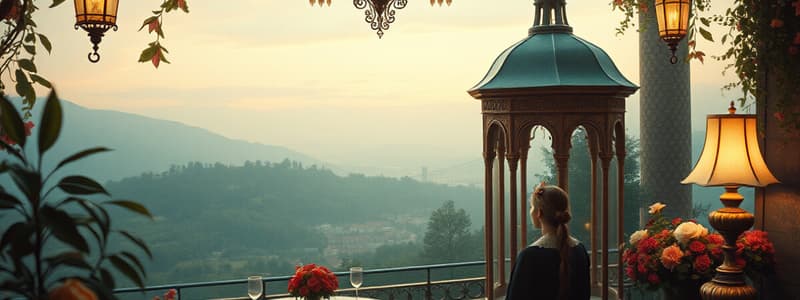Podcast
Questions and Answers
Technicolor was notable for
Technicolor was notable for
- Its rich, saturated hues. (correct)
- Its ease of use during shooting.
- Its need for less light than earlier color processes.
- Its soft, warm pastels.
Tinting and toning are
Tinting and toning are
- Methods of using filters to change the color of the light on the set.
- Printing techniques used to correct flaws in an image's color.
- Makeup used to adjust skin tones to suit the color balance of the film stock.
- Methods for using dyes used to add color to black-and-white film. (correct)
The projection speed for sound films was first standardized at
The projection speed for sound films was first standardized at
- 50 feet per minute.
- 36 frames per second.
- 24 frames per second. (correct)
- 30 minutes per reel.
Which of the following is NOT affected by the focal length of the camera lens?
Which of the following is NOT affected by the focal length of the camera lens?
A zoom lens is a
A zoom lens is a
'Depth of field' refers to
'Depth of field' refers to
Deep-focus cinematography was popularized in 1940s in part by
Deep-focus cinematography was popularized in 1940s in part by
Which of the following statements is NOT true concerning Peter Jackson's use of computer-generated imagery in The Lord of the Rings trilogy?
Which of the following statements is NOT true concerning Peter Jackson's use of computer-generated imagery in The Lord of the Rings trilogy?
'Contrast' refers to
'Contrast' refers to
Which of the following is NOT a type of composite filming?
Which of the following is NOT a type of composite filming?
Slices of glass or gelatin placed in front of the lens of a camera to prevent certain frequencies of light from reaching the film are called
Slices of glass or gelatin placed in front of the lens of a camera to prevent certain frequencies of light from reaching the film are called
Which of the following describes a type of widescreen image?
Which of the following describes a type of widescreen image?
An anamorphic process
An anamorphic process
In cinematography, 'mask' refers to
In cinematography, 'mask' refers to
In a canted camera position, objects on the screen appear
In a canted camera position, objects on the screen appear
Terms for camera distance, such as 'medium shot,' are based on
Terms for camera distance, such as 'medium shot,' are based on
Flashcards are hidden until you start studying
Study Notes
Cinematic Techniques and Terminology
- Technicolor: Known for its rich, saturated hues, enhancing visual storytelling.
- Tinting and Toning: Methods using dyes to add color to black-and-white films, expanding the visual palette.
- Projection Speed: Standardized at 24 frames per second for sound films, ensuring consistent playback.
Camera Mechanics
- Focal Length Effects: Magnification, depth, and scale are influenced by focal length, while aspect ratio remains unaffected.
- Zoom Lens: Capable of changing focal lengths during filming, allowing dynamic adjustment of shot composition.
- Depth of Field: Refers to the range of distances in a shot that remain in focus, critical for visual clarity.
Historic References
- Deep-Focus Cinematography: Popularized in the 1940s by "Citizen Kane," allowing foreground and background to be in focus simultaneously.
- Peter Jackson's CGI in The Lord of the Rings: Utilized for creating individual characters and digital stunt doubles; not primarily for populating scenes with crowds.
Visual Composition
- Contrast: The distinction between the darkest and lightest areas in a frame, crucial for visual drama and impact.
- Composite Filming Types: Includes Matte, Rear Projection, and Front Projection; Racking is not a recognized type.
- Filters: Glass or gelatin slices that block specific light frequencies from hitting the film, influencing exposure and color.
Image Formats
- Widescreen Image Types: Hard matte serves as a method for widescreen presentation.
- Anamorphic Process: Squeezes a widescreen image onto film, facilitating the capture of a wider aspect ratio.
- Masking Technique: Alters the frame shape for creative visual storytelling.
Camera Angles and Distances
- Canted Camera Position: Results in a tilted horizon line, creating an unbalanced aesthetic.
- Camera Distance Terminology: Terms like "medium shot" relate to the size of figures in relation to the frame, not actual distances from the camera.
These notes encapsulate the key concepts and terminology relevant to the study of cinematography and visual composition.
Studying That Suits You
Use AI to generate personalized quizzes and flashcards to suit your learning preferences.




